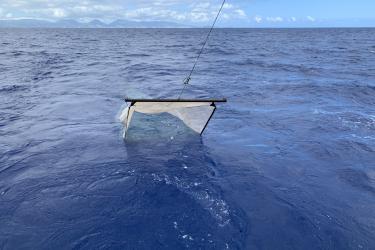The bottomfish research expedition is progressing along nicely and the work is keeping the scientists very busy. The day begins early as the crew meet to discuss the day’s bottomfish sampling locations. The small boats are then deployed to commence pursuit of the “Deep 7” samples required, including the Hawaiian grouper, known as hapu‘upu‘u, and the six species of deep-water snappers (opakapaka, ehu, onaga, lehi, gindai, and kalekale). The team is sampling for bottomfish at depths, ranging from 100 to 400 meters, and occasionally has to deal with the local shark populations, or “the taxman” as a Sette crewmen refers to them, snacking on the catch and creating disruptions.

Eddie Ebisui III shows off an opakapaka prior to taking fin clips and releasing the fish.

Bottomfish sampling from the NOAA Ship Sette.
Aboard NOAA Ship Oscar Elton Sette, operations continue with bottomfish sampling and the periodic Isaac-Kid trawl modified for use on the surface to catch juvenile shore fish. Upon completion of bottomfish sampling operations and recovery of the small boats, the team then prepares for the next day’s work by tying lures.

Team prepares for the next day by tying lures.

Operations commence to obtain depth profiles of temperature, salinity, oxygen, and chlorophyll content with CTDs. This is accomplished by deploying a CTD, attached to a frame, and lowering it to the bottom of the water column. The CTD sensor measures conductivity, temperature and depth. Also attached to the frame are Niskin water bottles. The water bottles are fired electronically from onboard at varying pre-determined depths within the water column. The water is then filtered and processed onboard the ship to determine water chemistry and chlorophyll content. These measurements will help to characterize the physical environment that pelagic stage bottomfish may be associated with and may lead to a better understanding of their environmental habitat.

Cobb trawl night operations aboard NOAA Ship Sette.
The Cobb midwater trawling operations begin at night about 25 nm offshore around Johnston Atoll. The net is towed at depths of 170-175, 100-125 and 20-25 meters in search for pelagic stage samples. When the net is brought back onboard, the sample is weighed and sorted and the scientists spend hours delicately separating the catch. Once this is done we start the operations again.



